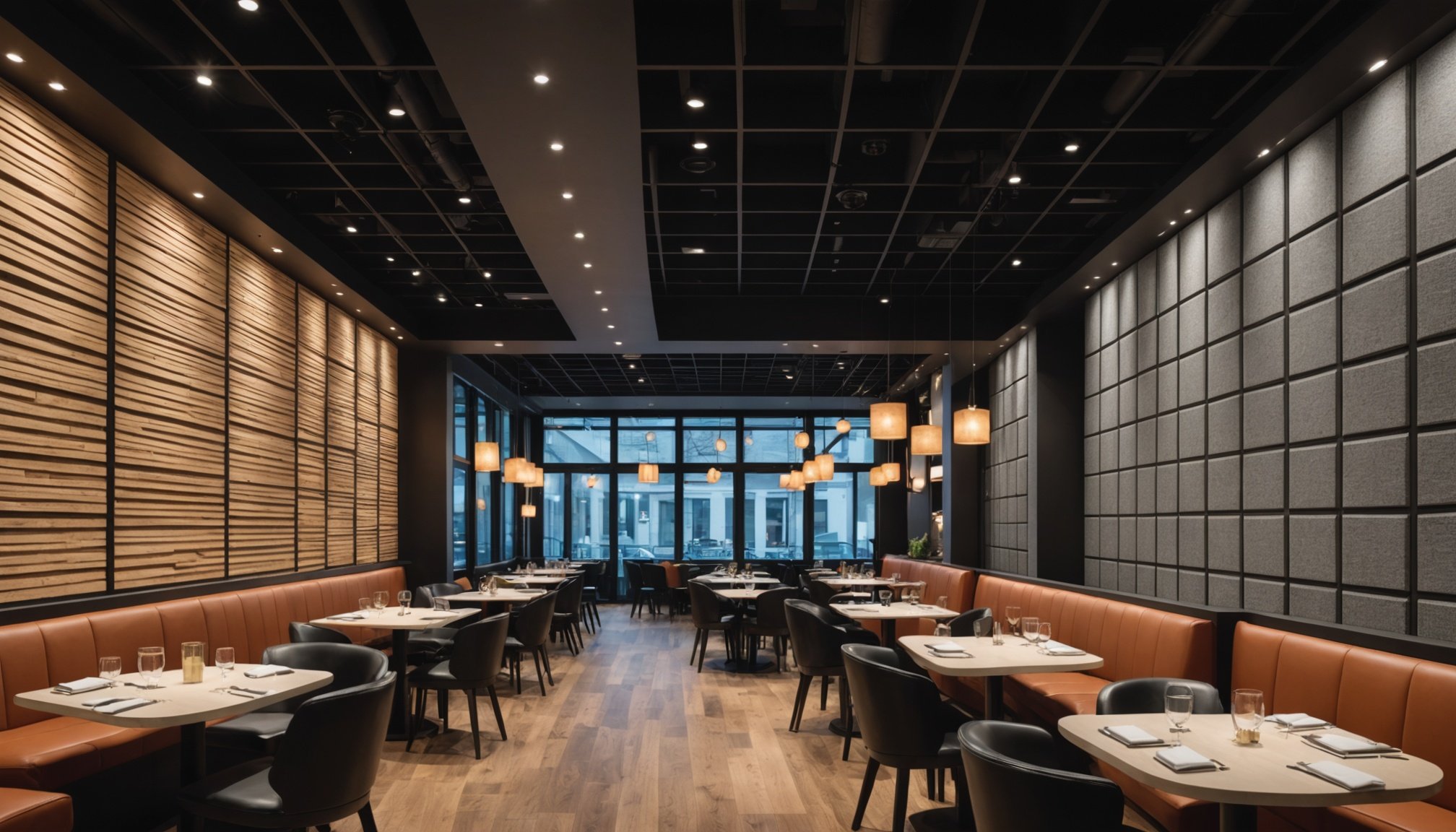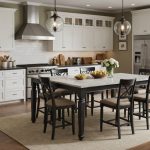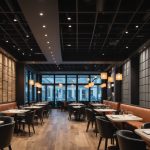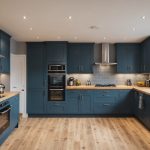Creating an inviting atmosphere in restaurants goes beyond just decor. Integrating acoustic panels can enhance both aesthetics and acoustics, ensuring a pleasant dining experience. Discover innovative design strategies that showcase these functional elements as art, transforming your space into a vibrant yet serene haven. Let’s explore how thoughtful integration of acoustic panels not only reduces noise but also elevates the overall vibe of your restaurant, enticing guests to return time and again.
Creative Design Strategies for Acoustic Panels
Exploring the fusion of function and form in restaurant spaces.
This might interest you : Crafting a Unique Tea-Pairing Experience: Elevating Your Traditional British Restaurant Menu
Importance of Aesthetics in Restaurant Design
Incorporating acoustic panels into your restaurant interior design is not just about sound management; it's about creating a visually appealing environment. The integration of these panels can enhance both the auditory and visual experience of diners. Visual appeal plays a crucial role in attracting and retaining customers, making it essential to choose designs that complement the restaurant's theme.
Creative Design Strategies
To seamlessly integrate acoustic panels, consider adopting creative strategies that align with your restaurant's aesthetic. Opt for panels that reflect the style and ambiance you aim to create. For instance, bold colors and geometric patterns can add a modern touch, while wood finishes might suit a rustic theme. Custom designs can also be commissioned to feature brand-specific elements or local artistry.
Tips for Selecting the Right Acoustic Panel Designs
- Consider the Theme: Ensure the acoustic panels align with your restaurant's overall theme.
- Material Matters: Choose materials that not only absorb sound but also enhance the decor.
- Balance Function and Form: Select designs that offer both aesthetic appeal and effective sound absorption.
By thoughtfully selecting and integrating acoustic panels, restaurant owners can create a harmonious environment that pleases both the eyes and ears.
Distinctive Acoustic Panel Examples
Exploring innovative designs and materials for sound absorption.
Customizable Acoustic Panels
Incorporating unique acoustic panels into restaurant spaces offers both decorative sound absorption and flexibility. Customizable options allow restaurant owners to tailor designs to their specific needs, ensuring that the panels complement the existing decor. This approach not only enhances the visual appeal but also optimizes sound management.
Benefits of Customizable Acoustic Panels:
- Adaptability: Easily match panels to the restaurant's theme.
- Personalization: Incorporate brand elements or local artistry.
- Functionality: Maintain effective sound absorption while enhancing aesthetics.
Nature-Inspired Acoustic Solutions
Nature-inspired acoustic panels provide a calming ambiance, drawing on organic shapes and textures. These designs often feature innovative materials like recycled wood or plant-based fibers, promoting sustainability.
Examples:
- Panels with leaf patterns for a tranquil vibe.
- Use of bamboo for an eco-friendly touch.
Artistic Acoustic Installations
Artistic installations transform decorative sound absorption into statement pieces. By collaborating with artists, restaurants can install panels that serve as both functional and artistic elements.
Examples:
- Murals integrated with sound-absorbing materials.
- Sculptural panels that double as art pieces.
By selecting innovative materials and designs, restaurants can achieve a harmonious blend of aesthetics and acoustics, creating an inviting atmosphere for diners.
Case Studies of Successful Implementations
Examining real-world examples of effective acoustic panel integration.
Notable Restaurant Examples
Several restaurants have successfully integrated acoustic panels into their designs, achieving a perfect balance of aesthetics and functionality. One such example is "The Green Leaf," a bistro known for its eco-friendly approach. By using nature-inspired acoustic solutions, they created a serene dining experience that aligns with their sustainability goals.
Lessons Learned:
- Consistency: Ensuring panels complement the overall design theme enhances customer satisfaction.
- Collaboration: Working with designers and artists can lead to innovative solutions.
- Customization: Tailored panels can reflect brand identity and improve ambiance.
Impact on Ambiance and Customer Experience
The integration of acoustic panels has shown a marked improvement in customer experience. At "Urban Echo," a bustling city restaurant, the use of artistic acoustic installations reduced noise levels significantly, creating a more intimate setting.
Impact Analysis:
- Increased Dwell Time: Patrons tend to stay longer in a comfortable environment.
- Positive Reviews: Enhanced acoustics often lead to better customer feedback.
- Repeat Visits: A pleasant atmosphere encourages return visits, boosting business.
By examining these acoustic panel success stories, restaurant owners can gain valuable insights into effective design strategies that enhance both ambiance and customer satisfaction.
Visual Inspiration for Restaurant Interiors
Exploring how visual elements can enhance the dining experience.
Curated Images of Restaurants Utilizing Acoustic Panels Creatively
Inspiring restaurant design often incorporates acoustic panel aesthetics to create a unique atmosphere. Consider a bistro with panels that mimic the texture of a rustic brick wall, adding warmth and character. Another example is a sleek, modern eatery where panels are arranged in a geometric pattern, offering a futuristic vibe.
Trends in Restaurant Interior Design Featuring Acoustic Solutions
Current trends in restaurant design inspiration emphasize the use of acoustic panel aesthetics as both functional and decorative elements. These panels are not just about sound absorption; they are integral to the overall visual design. Visual design trends include the use of vibrant colors and innovative materials, like recycled fabrics or natural fibers, to create an eco-friendly ambiance.
Enhancing Dining Experience Through Visual Elements
Visual design plays a pivotal role in enhancing the dining experience. The strategic use of acoustic panel aesthetics can transform a space, making it more inviting and comfortable. For instance, panels with artistic designs can serve as focal points, drawing diners' attention and creating a memorable atmosphere.
- Texture: Adds depth and interest.
- Color: Sets mood and tone.
- Pattern: Offers visual rhythm and continuity.
By embracing restaurant design inspiration, establishments can effectively use acoustic panel aesthetics to elevate their interiors.
Practical Tips for Balancing Aesthetics with Functionality
Ensuring your restaurant design is both visually appealing and acoustically effective.
Guidelines for Material and Color Selection
Choosing the right acoustic panel installation materials and colors is crucial for maintaining both design functionality and aesthetic appeal. Opt for materials that complement your restaurant's theme while providing effective sound absorption. For instance, soft fabrics work well in elegant settings, while vibrant colors can energize a modern space.
Material Selection Tips:
- Fabric: Ideal for a cozy, intimate atmosphere.
- Wood: Offers a rustic, warm feel.
- Metal: Adds a sleek, contemporary touch.
Installation Techniques
Proper acoustic panel installation ensures that panels blend seamlessly with the decor. Consider hidden mounting systems to maintain a clean look. Panels can also be installed in patterns to enhance visual interest without compromising design functionality.
Ensuring Acoustic Effectiveness
To achieve optimal sound management, strategically place panels where noise levels are highest. Balance is key; too many panels can overwhelm the decor, while too few may not be effective. Test different configurations to find the right mix of design functionality and acoustic performance.
By following these practical design tips, restaurant owners can create a harmonious environment that is both beautiful and acoustically sound.
Future Trends in Restaurant Acoustic Design
Exploring the innovative future of sound and design integration.
Emerging Design Trends
As the future of restaurant interiors evolves, new acoustic innovations are set to redefine the dining experience. Designers are increasingly focusing on sound and design integration, utilizing advanced materials and technologies. Expect to see a rise in smart acoustic panels that adjust sound levels based on occupancy and noise levels. These panels not only enhance the dining atmosphere but also contribute to energy efficiency.
Predictions for Restaurant Aesthetics
The future of restaurant interiors will likely see a blend of acoustic innovations with aesthetic enhancements. A move towards biophilic design, incorporating natural elements into acoustic solutions, is anticipated. This trend aligns with the growing demand for sustainable and eco-friendly designs. Acoustic innovations will continue to influence the future of restaurant interiors by integrating seamlessly with decor, creating immersive environments.
Role of Technology
Technology plays a crucial role in acoustic innovations, offering tools for precise sound management. Digital modeling and simulation allow designers to predict and optimize acoustics in restaurant spaces. Smart acoustic systems can be programmed to adapt to different events, ensuring optimal sound levels. As technology advances, the future of restaurant interiors will increasingly rely on these innovations to enhance both functionality and aesthetics.
- Smart Panels: Adaptive sound management
- Biophilic Design: Incorporating nature
- Digital Simulation: Predictive acoustics











